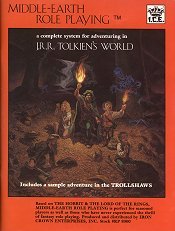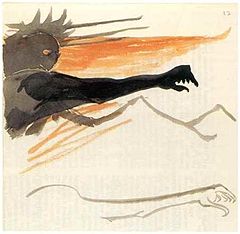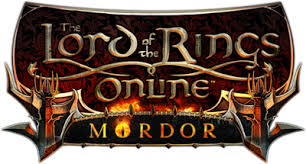
Gorgoroth is a supplement published by Iron Crown Enterprises (ICE) in 1990 for the fantasy role-playing game Middle-earth Role Playing (MERP), which is itself based on the works of J.R.R. Tolkien.

Gorgoroth is a supplement published by Iron Crown Enterprises (ICE) in 1990 for the fantasy role-playing game Middle-earth Role Playing (MERP), which is itself based on the works of J.R.R. Tolkien.
In Tolkien's published history of Middle Earth, following the fall of Numenor, Sauron realized that Gondor, the kingdom established by Elendil and his son Isildur, would rival lost Numenor in power and prestige, and created the country of Mordor to contest Gondor's might. The Plateau of Gorgoroth lay in the northwest corner of Mordor, and it was here, near the base of the volcano Mount Doom that Sauron established his fortress of Barad-dur. [1]
Gorgoroth is a campaign setting which details the Plateau of Gorgoroth and its surrounding terrain and peoples so that a gamemaster can set MERP adventures within these lands. [2] The book is divided into four main parts:
Part 1: Guidelines for the gamemaster
Part 2: Mordor
Part 3: Locations of interest outside Mordor
Part 4: Campaign Aids
ICE published the licensed game Middle Earth Role-Playing in 1982, and then released many supplements for it over the next 17 years, until the Tolkien Estate withdrew their license in 1999. Gorgoroth, a 144-page softcover book with removable color map published by Iron Crown Enterprises in 1990, was written by John Crowdis, Keith Robley, Anders Blixt, Pete Fenlon, Coleman Charlton, and Jessica Ney, with interior art by Darrell Midgette and Liz Danforth, cartography by William Hyde, Jennifer Kleine, Kevin William, and Pete Fenlon, and cover art by Angus McBride. [2]

Gondor is a fictional kingdom in J. R. R. Tolkien's writings, described as the greatest realm of Men in the west of Middle-earth at the end of the Third Age. The third volume of The Lord of the Rings, The Return of the King, is largely concerned with the events in Gondor during the War of the Ring and with the restoration of the realm afterward. The history of the kingdom is outlined in the appendices of the book.
Gil-galad is a fictional character in J. R. R. Tolkien's Middle-earth legendarium, the last High King of the Noldor, one of the main divisions of Elves. He is mentioned in The Lord of the Rings, where the hobbit Sam Gamgee recites a fragment of a poem about him, and The Silmarillion. In the Last Alliance of Elves and Men, Gil-galad and Elendil laid siege to the Dark Lord Sauron's fortress of Barad-dûr, and fought him hand-to-hand for the One Ring. Both Gil-galad and Elendil were killed, and Elendil's son Isildur took the Ring for himself. Gil-galad briefly appears at the opening of Peter Jackson's The Lord of the Rings film trilogy, and features in several video games based on Tolkien's Middle-earth.

Middle-earth Role Playing (MERP) is a 1984 role-playing game based on J. R. R. Tolkien'sThe Lord of the Rings and The Hobbit under license from Tolkien Enterprises. Iron Crown Enterprises (I.C.E.) published the game until they lost the license on 22 September 1999.
Elendil is a fictional character in J. R. R. Tolkien's legendarium. He is mentioned in The Lord of the Rings, The Silmarillion and Unfinished Tales. He was the father of Isildur and Anárion, last lord of Andúnië on the island of Númenor, and having escaped its downfall by sailing to Middle-earth, became the first High King of Arnor and Gondor. In the Last Alliance of Men and Elves, Elendil and Gil-galad laid siege to the Dark Lord Sauron's fortress of Barad-dûr, and fought him hand-to-hand for the One Ring. Both Elendil and Gil-galad were killed, and Elendil's son Isildur took the Ring for himself.
In J. R. R. Tolkien's fantasy writings, Isengard is a large fortress in Nan Curunír, the Wizard's Vale, in the western part of Middle-earth. In the fantasy world, the name of the fortress is described as a translation of Angrenost, a word in the elvish language Sindarin, which Tolkien invented.

Iron Crown Enterprises (ICE) is a publishing company that has produced role playing, board, miniature, and collectible card games since 1980. Many of ICE's better-known products were related to J. R. R. Tolkien's world of Middle-earth, but the Rolemaster rules system, and its science-fiction equivalent, Space Master, have been the foundation of ICE's business.

In J. R. R. Tolkien's high fantasy The Lord of the Rings, Harad is the immense land south of Gondor and Mordor. Its main port is Umbar, the base of the Corsairs of Umbar whose ships serve as the Dark Lord Sauron's fleet. Its people are the dark-skinned Haradrim or Southrons; their warriors wear scarlet and gold, and are armed with swords and round shields; some ride gigantic elephants called mûmakil.
In J. R. R. Tolkien's epic fantasy novel The Lord of the Rings, the Battle of the Morannon or the Battle of the Black Gate, is the final confrontation in the War of the Ring. Gondor and its allies send a small army ostensibly to challenge Sauron at the entrance to his land of Mordor; he supposes that they have with them the One Ring and mean to use it to defeat him. In fact, the Ring is being carried by the hobbits Frodo Baggins and Sam Gamgee into Mordor to destroy it in Mount Doom, and the army is moving to distract Sauron from them. Before the battle, a nameless leader, the "Mouth of Sauron", taunts the leaders of the army with the personal effects of Frodo and Sam. Battle is joined, but just as it seems the army of Gondor will be overwhelmed, the Ring is destroyed, and the forces of Sauron lose heart. Mount Doom erupts, and Sauron's tower, Barad-dûr, collapses, along with the Black Gate. The army of Gondor returns home victorious, the War of the Ring won.

In J. R. R. Tolkien's legendarium, the history of Arda, also called the history of Middle-earth, began when the Ainur entered Arda, following the creation events in the Ainulindalë and long ages of labour throughout Eä, the fictional universe. Time from that point was measured using Valian Years, though the subsequent history of Arda was divided into three time periods using different years, known as the Years of the Lamps, the Years of the Trees and the Years of the Sun. A separate, overlapping chronology divides the history into 'Ages of the Children of Ilúvatar'. The first such Age began with the Awakening of the Elves during the Years of the Trees and continued for the first six centuries of the Years of the Sun. All the subsequent Ages took place during the Years of the Sun. Most Middle-earth stories take place in the first three Ages of the Children of Ilúvatar.
Númenor, also called Elenna-nórë or Westernesse, is a fictional place in J. R. R. Tolkien's writings. It was the kingdom occupying a large island to the west of Middle-earth, the main setting of Tolkien's writings, and was the greatest civilization of Men. However, after centuries of prosperity many of the inhabitants ceased to worship the One God, Eru Ilúvatar, and rebelled against the Valar, resulting in the destruction of the island and the death of most of its people. Tolkien intended Númenor to allude to the legendary Atlantis. Commentators have noted that the destruction of Númenor echoes the Biblical stories of the fall of man and the destruction of Sodom and Gomorrah, and John Milton's Paradise Lost.
Isildur is a fictional character in J. R. R. Tolkien's Middle-earth, the elder son of Elendil, descended from Elros, the founder of the island Kingdom of Númenor. He fled with his father when the island was drowned, becoming in his turn King of Arnor and Gondor. He cut the Ring from Sauron's hand, but instead of destroying it, was corrupted by its power and claimed it for his own. He was killed by orcs, and the Ring was lost in the River Anduin. This set the stage for the Ring to pass to Gollum and then to Bilbo, as told in The Hobbit; that in turn provided the central theme, the quest to destroy the Ring, for The Lord of the Rings.

In J. R. R. Tolkien's fictional world of Middle-earth, Mordor is the realm and base of the evil Sauron. It lay to the east of Gondor and the great river Anduin, and to the south of Mirkwood. Mount Doom, a volcano in Mordor, was the goal of the Fellowship of the Ring in the quest to destroy the One Ring. Mordor was surrounded by three mountain ranges, to the north, the west, and the south. These both protected the land from invasion and kept those living in Mordor from escaping.

Sauron is the title character and the primary antagonist, through the forging of the One Ring, of J. R. R. Tolkien's The Lord of the Rings, where he rules the land of Mordor and has the ambition of ruling the whole of Middle-earth. In the same work, he is identified as the "Necromancer" of Tolkien's earlier novel The Hobbit. The Silmarillion describes him as the chief lieutenant of the first Dark Lord, Morgoth. Tolkien noted that the Ainur, the "angelic" powers of his constructed myth, "were capable of many degrees of error and failing", but by far the worst was "the absolute Satanic rebellion and evil of Morgoth and his satellite Sauron". Sauron appears most often as "the Eye", as if disembodied.

Terry K. Amthor was an American game designer who worked primarily on role-playing games, and as a fantasy author.
The geography of Middle-earth encompasses the physical, political, and moral geography of J. R. R. Tolkien's fictional world of Middle-earth, strictly a continent on the planet of Arda but widely taken to mean the physical world, and Eä, all of creation, as well as all of his writings about it. Arda was created as a flat world, incorporating a Western continent, Aman, which became the home of the godlike Valar, as well as Middle-earth. At the end of the First Age, the Western part of Middle-earth, Beleriand, was drowned in the War of Wrath. In the Second Age, a large island, Númenor, was created in the Great Sea, Belegaer, between Aman and Middle-earth; it was destroyed in a cataclysm near the end of the Second Age, in which Arda was remade as a spherical world, and Aman was removed so that Men could not reach it.

The Lord of the Rings Online: Mordor is the sixth expansion for The Lord of the Rings Online MMORPG, released on July 31, 2017. It raised the game's level cap from 105 to 115 and added a new Plateau of Gorgoroth region in Mordor, which the Free People of Middle-Earth begin to explore following the downfall of Sauron, as well as a new cluster of end-game Instances and a Raid.

Erech and the Paths of the Dead is a supplement published by Iron Crown Enterprises (ICE) in 1985 for the fantasy role-playing game Middle-earth Role Playing, which is itself based on the works of J.R.R. Tolkien.

Lórien & The Halls of the Elven Smiths is a supplement published by Iron Crown Enterprises (ICE) in 1986 for the fantasy role-playing game Middle-earth Role Playing, which is itself based on the works of J.R.R. Tolkien.

Trolls of the Misty Mountains is a supplement published by Iron Crown Enterprises (ICE) in 1986 for the fantasy role-playing game Middle-earth Role Playing (MERP), which is itself based on the works of J.R.R. Tolkien.
The architecture in Middle-earth, J. R. R. Tolkien's fictional world, is as varied as the Hobbit-holes of the Shire, the tree-houses of Lothlórien, the wooden halls of Rohan, and the stone dwellings and fortifications of Minas Tirith, capital of Gondor. Tolkien uses the architecture in each place, including its interior design, to provide clues to each people's character. The Hobbit Bilbo Baggins's cosy home, Bag End, described in his 1937 children's book The Hobbit, establishes the character of Hobbits as averse to travelling outside the Shire. In his fantasy novel The Lord of the Rings, Lothlórien demonstrates the close integration of the Elves with their natural environment. The King of Rohan's hall, Meduseld, indicates the Rohirrim's affinity with Anglo-Saxon culture, while Gondor's tall and beautiful stone architecture was described by Tolkien as "Byzantine". In contrast, the Dark Lord Sauron and the fallen Wizard Saruman's realms are damaged lands around tall dark towers.